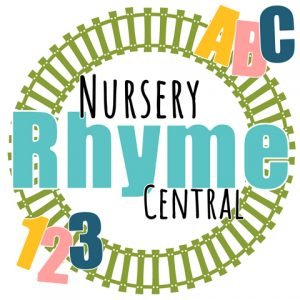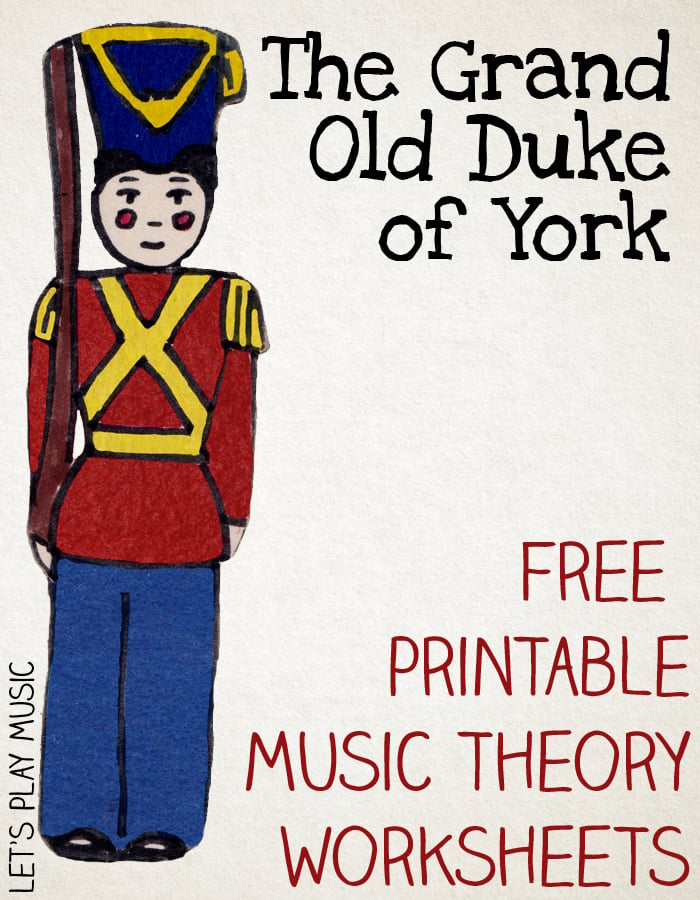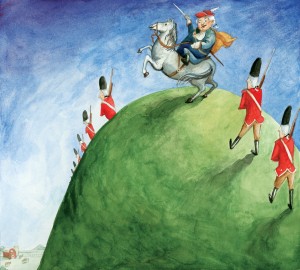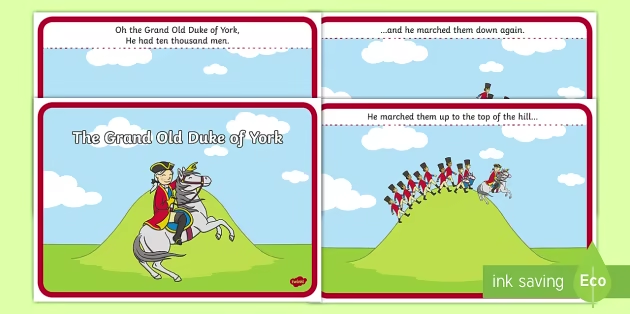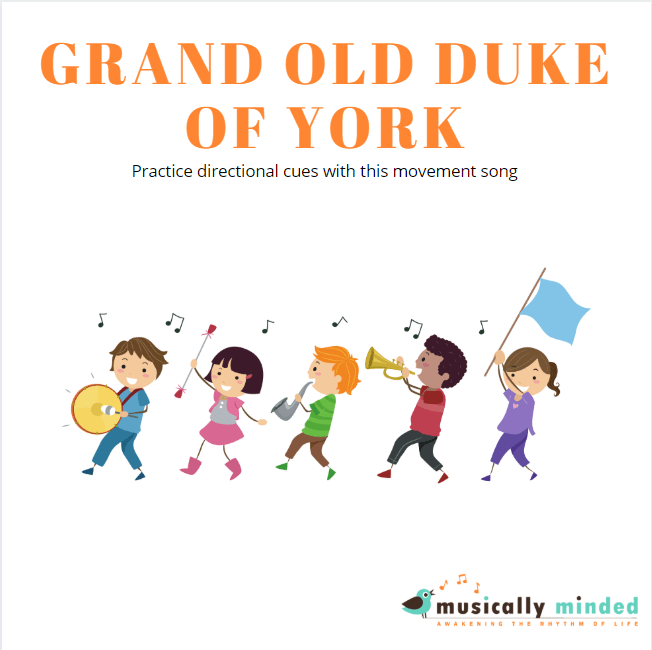The Grand Old Duke of York is a famous nursery rhyme with marching actions. But have you ever wondered who the duke in the Grand Old Duke of York is?
I asked myself the same question when I first heard the song. It’s the reason I researched the song’s history to get the full story behind it.
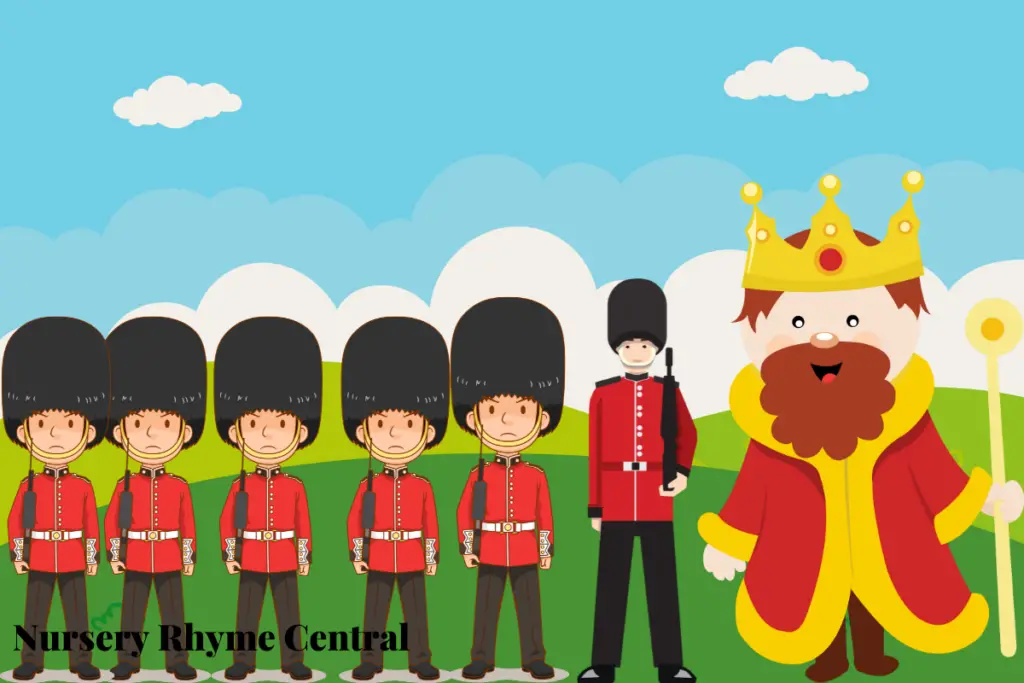
Here is what I found.
LYRICS
Lyrics For The Grand Old Duke of York as Sung Today
The lyrics as sung today comprise only two stanzas sung repeatedly.
Oh, the grand old Duke of York,
He had ten thousand men,
He marched them up to the top of the hill
And he marched them down again.
And when they were up, they were up,
And when they were down, they were down,
And when they were only halfway up
They were neither up nor down.
Full Original Lyrics for The Grand Old Duke of York
The Grand Old Duke of York has an unclear history. The first lyrics of the song from 1642 are only two lines. No Duke is present in the lines since the song refers to Napoleon of France.
This version is often called Old Tarlton’s song. The name refers to a French clown who went by the name Richard Tarlton.
The King of France, with forty thousand men,
Came up a hill and so came downe againe
The Dutch Version Lyrics
A Dutch version of the song exists. It pays tribute to Maurice, Prince of Orange.
De held prins Maurits kwam
met honderdduizend man
daar ging hij mee de heuvel op
en ook weer naar benee
en was ‘ie bovenan
dan was ‘ie niet benee
en was ‘ie halverwege
was ‘ie boven noch benee
Translation
The hero Prince Maurice came
with a hundred thousand men
with them, he went up the hill
and also down again
and when he was up
then he wasn’t down
and when he was halfway
he was neither up nor down
HISTORY BEHIND THE GRAND OLD DUKE OF YORK
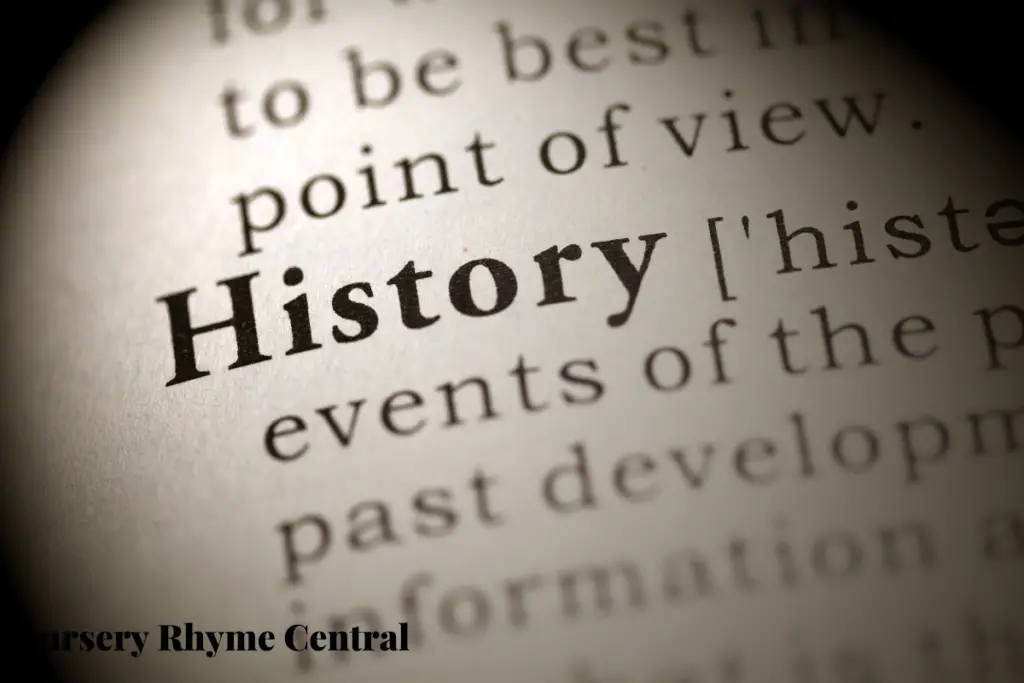
Who Wrote The Grand Old Duke of York?
It is unclear who first came up with the Grand Old Duke of York. What’s evident is that historical events inspired its writing.
Though unclear who wrote the song, what takes center stage for the song is the subject of the rhyme.
The version we sing today first appeared in 1913 in Mother Goose, a book by Arthur Rackham.
Some texts we read about this rhyme credit the first-ever writing of the song to Richard Tarlton. It is possible Tarlton’s version inspired the modern version of the song.
However one of our kind readers Etienne wrote to us to inform us that the relationship of the Grand Old Duke to Tarlton’s version has to be a mistake.
She wrote:
Thank you for the great post related to The old grand duke of York. Unfortunately there is a mistake in the part related to Old Taltorn’s song. It cannot refer to Napoleon as he wasn’t born yet (born in 1762). The king of France by then was Louis XIII for one more year as he died in 1643. Unfortunately I cannot find any precise reference to which battle Old Taltorn’s song refers to.
Thanks Etienne – for writing into us and sharing this great piece of information to help us ensure the history of these rhymes is shared accurately with everyone!!!
WHAT DO THE WORDS IN THE GRAND OLD DUKE OF YORK MEAN? DEFINITIONS
What’s the meaning of the Grand Old Duke of York Rhyme?
Though the song has no special meaning, it is used proverbially to mean futile action, especially in military circles. Going up the hill and then back down is seen as useless. It doesn’t lead to any noteworthy events.
Who is a Duke?
A duke is a royal family member with a high hereditary rank. The name is common in the British royal family. The duke is often someone close in line to the throne.
What Does the Duke of York Mean?
Duke of York is a nobility title that’s part of the Peerage of the United Kingdom. When given, it was initially given to the second sons in the English (and now British) royal families.
The current Duke of York is Prince Andrew, Queen Elizabeth II’s second son. At the moment, he is ninth in line to the British throne. (If you are reading this and it has changed – please contact me on the link at the bottom of the page so I can update this information!)
Where is York?
York is a city in the North East of England. It is one of the most historic cities in England, with many old public houses and castles.
What is a Hill?
A hill is an area of land that’s raised. It isn’t as tall as a mountain and is usually less craggy.
Why Was the Duke Marching His Men Up and Down the Hill?
From historical collections, it seems the duke was marching his men up the hill to prepare for war.
In the olden days, intercountry conflicts often saw different countries take arms against each other.
INTERESTING FACTS & QUESTIONS ANSWERED
Is The Grand Old Duke of York Based on a Person from History
The Grand Old Duke of York refers to a historical personality. Just which person it is has been subject to many debates for years. Let’s look at the candidates for the title.
- Richard Duke of York (Born 1411- Died 1460)
Some historians say the duke in the rhyme is Richard Duke of York, who had a futile battle at Wakefield and was killed. Richard of York was the father of Richard III and Edward IV.
He gave this “futile” battle in the War of Roses in December 1460 and fell to the Lancastrians. Richard had an army of about 8000 men when he went to wage war. This number was easily undone by the superior numbers of the Lancastrian forces, and he lost close to one-half of his men.
- James the Second (Born 1633-Died 1701)
The second person considered the subject of the rhyme is James II. In 1688 he went with his troops to Salisbury plain only to retreat without fighting.
That ties into the dukes’ soldiers marching up a hill and back down doing nothing. It could explain why some people think he is the duke referred to in the song.
- Frederick Duke of York
According to History Extra, many think Frederick Duke of York is the most likely subject of the rhyme. Frederick was the chief commander of the British army when the Napoleonic wars were raging.
While the Flanders where the duke led his troops are relatively flat, they are next to the French town of Cassel. The town is rather hilly, explaining the soldiers’ marching up the hill.
Frederick’s men had some success in the fights against the French but were forced to retreat to the Netherlands.
Though several dukes are linked to the song, it isn’t clear which one the song refers to. Besides the duke title, there’s little evidence linking any of the occurrences in the song to a specific duke.
Therefore, though the rhyme is based on a historical person, it is unclear who that person is.
Is The Dutch Version A Corruption of The Original?
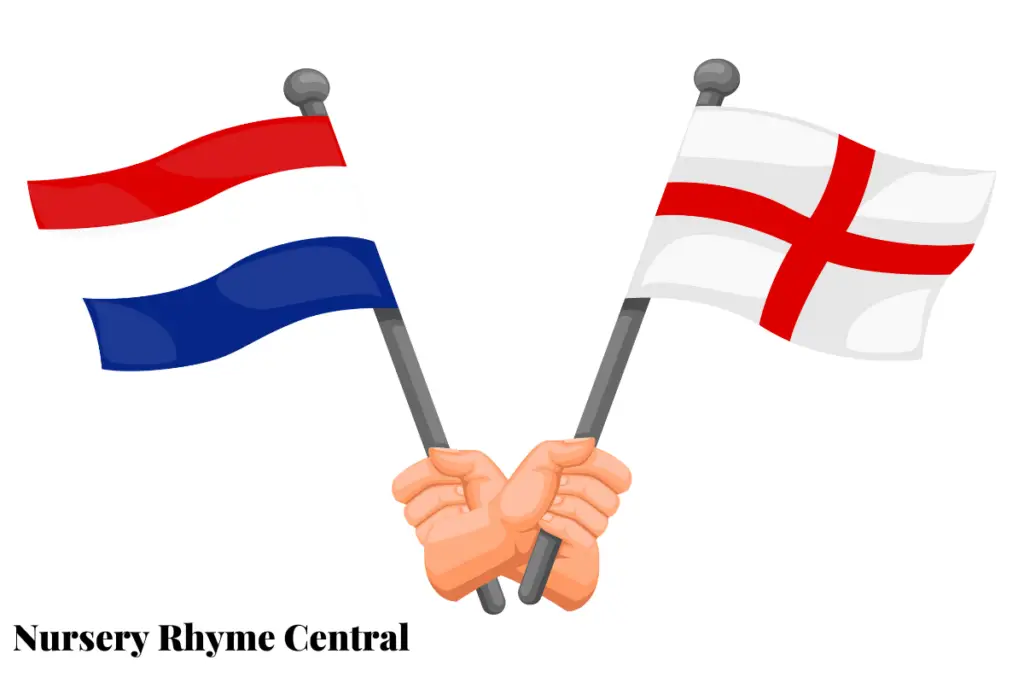
Yes, it is. The rhyme originated in England. However, it crossed the sea and landed in the Netherlands, praising Maurice Prince of Orange.
It’s unclear when the song crossed borders to the Netherlands. Today, the Dutch version is still famous and is a common song among the Dutch Scouting Movement members.
How Many Men Were with The Grand Old Duke of York?
The most famous version of the song lists ten thousand men. However, different versions have different numbers. In the Dutch version, Maurice, Prince of Orange, had a hundred thousand soldiers.
The king has forty thousand men in the French version of the song. The actual number of the men is up for debate, as is the actual identity of the duke.
Relationship Between Prince Andrew and The Grand Old Duke of York Rhyme
In 2019, Emily Maitlis of the BBC interviewed Prince Andrew Duke of York. His responses to the interview questions elicited adverse reactions from the public.
It also led to the rock band, The Kunts, recording a version of the Grand Old Duke of York that mocked him. The song was called Prince Andrew Is a Sweaty Nonce” and had lyrics directly referring to the nursery rhyme of the Grand Old Duke of York.
Singing Actions for the Grand Old Duke of York
The Grand Old Duke of York is an action song. So, you can’t sing it while seated, especially for children.
People have different actions to go with the song. But below are the most common actions.
Oh, the grand old Duke of York
He had ten thousand men
He marched them up to the top of the hill
(Everyone stands up and does marching actions)
And he marched them down again
(Everyone sits down)
And when they were up, they were up
(Everyone stands up to resume the marching action)
And when they were down, they were down
(Everyone sits down)
And when they were only halfway up
Everyone stands halfway up
They were neither up nor down
Of course, adding other actions you think are better for the song is okay.
Is the Grand Old Duke of York in The Public Domain?
Yes, Grand Old Duke of York is a public-domain song. No one has the copyright to the music. Therefore, you can use it in your work. (Disclaimer: This is a general–not a legally confirmed fact, and you need to research the laws in your jurisdiction/country to ensure you may use this song).
The Grand Old Duke of York Rhyme was first published years before 1925. Any work copyrighted or published before 1925 is in the public domain today.
However, you can’t use someone’s song’s adaptation without permission. This applies to popular versions on YouTube. You can’t use such versions without the consent of the owners.
Can You Sing the Grand Old Duke of York in Sign Language?
You can sing The Grand Old Duke of York in sign language. Below is a helpful resource I found on YouTube.
THE GRAND OLD DUKE OF YORK INSPIRED LESSON PLANS
The following is a selection of Lesson Plans that I have found inspired by the Grand Old Duke of York Nursery Rhyme.
Other websites host all the lessons, so you will need to click on the images to learn more and download their resources.
SHEET MUSIC FOR THE GRAND OLD DUKE OF YORK
What Time Signature is Grand Old Duke of York Played In
The Grand Old Duke of York nursery rhyme has a time signature of 2/2. That is one of the simplest time signatures, making it easy to play the song.
HOW TO PLAY THE GRAND OLD DUKE OF YORK ON AN INSTRUMENT
You can play Grand Old Duke of York with different instruments. Look through the below resources to practice with the device of your choice.
